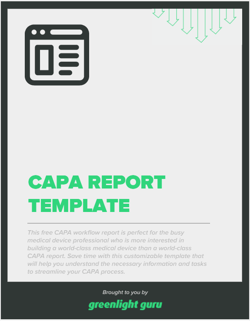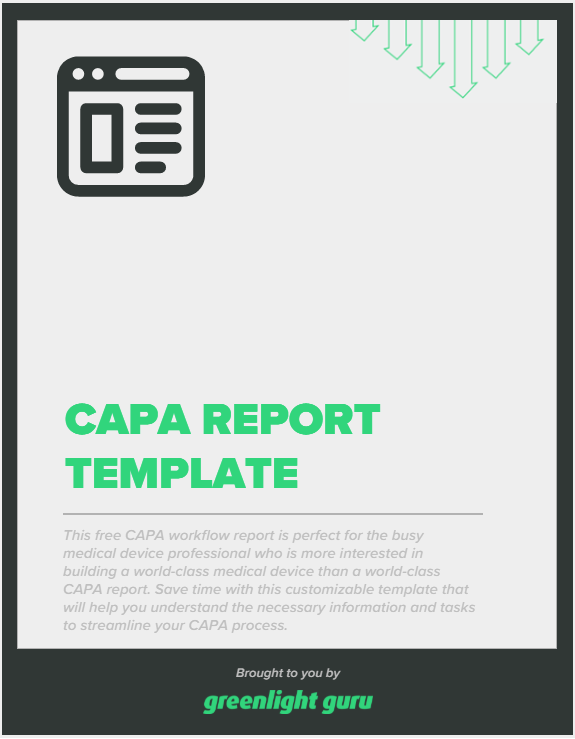CAPA Best Practices: 4 Tips for Building an Excellent CAPA Process

An effective CAPA process is one of the most important parts of your quality management system (QMS). It’s your tool for addressing systemic or highly critical issues in your manufacturing or quality processes.
And yet, according to our 2022 Industry Benchmark Report, only 17% of the medical device companies surveyed said they had achieved “excellence” with their CAPA process. Roughly half said their CAPA process was average or below average.
If you aren’t part of that 17%, then check out these CAPA best practices that will help take your CAPA system from average to excellent.
The top 4 CAPA best practices
1. Establish and follow your CAPA procedures
This first piece of advice may seem like a no-brainer, but missing or inadequate CAPA procedures has been the top cause of 483s and warning letters from FDA for over a decade. You need to take the time to create a compliant CAPA procedures document that details the guidelines for your organization’s approach to corrective and preventive actions.
Your CAPA procedures should define the objectives, criteria, steps and responsibilities of your CAPA system, and it should contain the following:
-
An overview of the CAPA procedures, including the scope, purpose, involved personnel, and list of external resources referenced in the document.
-
Definitions of terms like “corrective action,” “incident,” or “nonconforming product.”
-
CAPA Process Flow, which lays out steps to the CAPA process and how it advances through each phase.
-
CAPA forms to be filled out when events occur, and as the investigation proceeds. This is your documentation and should be centralized.
-
Additional information explaining the role of management in the review process.
Be sure to get input from every department and all your subject matter experts on your CAPA procedures document, as well as your SOPs and work instructions. Getting cross-functional input is the best way to ensure that people will actually follow the SOPs you’ve created.
2. Use a proactive CAPA methodology
When it comes to CAPA management, corrective action is usually the star of the show. It’s human nature to react to problems rather than seek out potential issues and prevent them from occurring.
On top of that, everyone knows preventive action is a part of CAPA, but they’re often not really sure what it means to take preventive action. The difference between the two comes down to a single word.
-
Corrective action is taken to prevent the recurrence of an issue.
-
Preventive action is taken to prevent the occurrence of an issue.
This IMDRF guidance document defines preventive action as “action to eliminate the cause of a potential nonconformity or other undesirable situation.”
So, by definition, preventive action is proactive. The same guidance document offers this example of what proactive action might look like:
For example, production or acceptance testing trend data indicates that control limits are being approached and revision of product or production (process, equipment or facilities) requirements may be necessary. These revisions could constitute a preventive action.
Notice that control limits are being approached. Nothing has technically gone wrong, but why wait until it does? Other actions that may fall under the preventive umbrella include:
-
Redesigning a process
-
Implementing training for staff
-
Instituting quarterly reviews with staff
-
Creating a new supplier agreement
-
Making improvements to a manufacturing environment
Remember, it feels good to put out fires, but it’s more efficient to stop them from occurring in the first place.
3. Perform root cause analysis (RCA) with a cross-functional team
Your root cause analysis is arguably the most important part of the CAPA quality process. If you can’t figure out what’s causing the issue—and I mean what’s really causing the issue—then you’ll likely be dealing with it again soon.
There are a number of different ways to perform RCA, and I can’t tell you which will be the most effective for you. But I can say you should involve a cross-functional team in the root cause analysis, whichever method you choose.
The reason you need a cross-functional team is that CAPAs, by their very nature, are rarely limited to one department or job function. The types of systemic issues that trigger CAPAs tend to involve multiple different areas within a business. And the point at which the problem is detected is often much farther downstream from the root cause.
If you leave root cause analysis to one or two individuals in the same department, it may be difficult to follow the thread of the problem all the way back to its true cause. When you build a cross-functional group, the team has access to every functional area, which increases cooperation and makes it easier to trace the problem to its source—wherever that may be.
4. Think carefully about initiating CAPAs
There are two traps that companies fall into with their CAPA methodology: underuse and overuse.
-
Underusing CAPAs is a serious issue because it means that quality events which should result in a CAPA—meaning a thorough investigation, root cause determination, and corrective or preventive action—are flying under the radar. That’s dangerous, not only for your business, but for the patients and end users your product is intended for.
-
Overusing CAPAs may not be as dangerous, but it’s still detrimental to your business. When companies get “CAPA happy,” they start opening a CAPA for every nonconformance or complaint they receive. And while a nonconformance or complaint may warrant a CAPA, it’s highly unlikely that they all will. CAPA happy companies tie up enormous resources in trying to close the large number of lingering CAPAs they keep open at all times.
If you’re unsure about whether you should open a CAPA, try asking these questions:
-
Did this event result in an injury? If the answer is yes, you should open a CAPA.
-
Is this a recurring issue? If the answer is yes, there’s a good chance the problem is systemic and you should open a CAPA.
-
Does a risk assessment show this to be a critical issue? Critical issues, even if they are not recurring, should trigger your CAPA process.
-
Can this issue be effectively managed another way, like through your nonconformance process, complaint handling, or change management? If you tend to suffer from overuse of CAPAs, this is a good question to begin asking before opening a new one.
Remember, CAPAs are for systemic or highly critical problems. Don’t be afraid to open a CAPA when it’s necessary, but don’t use the process as a catch-all for every quality issue you encounter.
Greenlight Guru builds CAPA best practices into your QMS from day one
CAPAs often take a back seat to other projects and initiatives that seem more important. But CAPA is more than just one more set of procedures in your QMS. The way you handle CAPAs is a primary indicator of the health of your company’s quality management system.
That’s why at Greenlight Guru, we built our eQMS with a dedicated CAPA Management Software workflow that makes it easy to effectively manage CAPAs from the moment a problem occurs to the moment you close the CAPA.
By managing all data and CAPA processes in a single system, you’ll understand how they relate to all other parts of your QMS and get visibility into how your customer complaints, audits, nonconformances, and other quality subsystems impact your CAPA system.
If you’re ready for cross-functional visibility into your CAPA process, then get your free demo of Greenlight Guru today →
Etienne Nichols is the Head of Industry Insights & Education at Greenlight Guru. As a Mechanical Engineer and Medical Device Guru, he specializes in simplifying complex ideas, teaching system integration, and connecting industry leaders. While hosting the Global Medical Device Podcast, Etienne has led over 200...
Read More Posts
QMSR Mythbusters Episode
The “just enough” QMS: what does your pre-market team really need?
Did Christmas come early to the EU? Proposal to simplify EUMDR
Get your free PDF
CAPA Report Template











